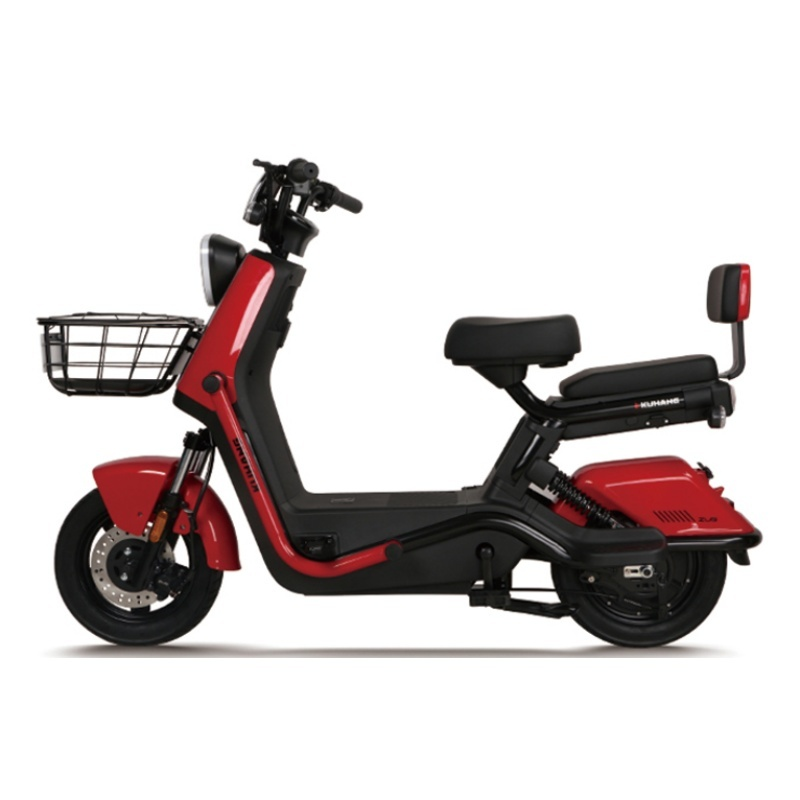ခေတ်မှီသယ်ယူပို့ဆောင်ရေးကို ပြောင်းလဲနေသော အီလက်ထရစ်တော်လှန်ရေး
လူသုံးယာဉ်တွေရဲ့ ရှုခင်းဟာ အံ့ဖွယ် ပြောင်းလဲမှုတစ်ခု ဖြတ်သန်းနေပါတယ်၊ လျှပ်စစ်ဆိုင်ကယ်တွေဟာ ပိုပြီး တည်တံ့ပြီး ထိရောက်တဲ့ အနာဂတ်ဆီကို ဦးဆောင်နေပါတယ်။ အင်း လျှပ်စစ်စက်ဘီး e-bike လို့လည်းခေါ်တဲ့ ဒီစက်ဘီးဟာ အစဉ်အလာ စက်ဘီးရဲ့ ဂန္ထဝင် ဒီဇိုင်းကို ခေတ်မီ လျှပ်စစ်နည်းပညာနဲ့ ပေါင်းစပ်ပေးပြီး ကမ္ဘာနှစ်ခုစလုံးရဲ့ အကောင်းဆုံးကို ပေးနိုင်တဲ့ ဟိုက်ဘရစ်ယာဉ်ကို ဖန်တီးပေးပါတယ်။ လျှပ်စစ်စက်ဘီးများတွင် ဘက်ထရီဖြင့် မောင်းနှင်သော စက်စနစ်ပါဝင်ပြီး စက်ဘီးစီးရာတွင် ကူညီပေးလျက် လူများ သွားလာရေး၊ လေ့ကျင့်ခန်းလုပ်ခြင်းနှင့် ပတ်ဝန်းကျင်ကို စူးစမ်းလေ့လာခြင်းတို့တွင် တော်လှန်ရေးကို ပြုလုပ်နေသည်။
မြို့များသည် ပိုမို၍ များပြားလာသော ယာဉ်ကြောပိတ်ဆို့မှုများနှင့် ပတ်ဝန်းကျင်ဆိုင်ရာ စိုးရိမ်မှုများကို ဦးစားပေးနေသောကြောင့် လျှပ်စစ်စက်ဘီးများသည် ခက်ခဲသော ပြဿနာများစွာကို ဖြေရှင်းပေးသော လက်တွေ့ကျသော ဖြေရှင်းချက်အဖြစ် ပေါ်ထွက်လာခဲ့သည်။ ဤတီထွင်သော ယာဉ်များသည် ပတ်ဝန်းကျင်ဆိုင်ရာ အကျိုးကျေးဇူးများကို ကျော်လွန်၍ ကွဲပြားသော အကျိုးကျေးဇူးများကို ပေးဆောင်သောကြောင့် တစ်ကိုယ်ရေသယံဇာတအဖြစ် ပိုမိုလွယ်ကူစွာ ဝင်ရောက်နိုင်သော နေရာကို ပေးဆောင်ပါသည်။ လေ့ကျင့်ခန်းလုပ်သော အမျိုးမျိုးသော အဆင့်အတန်းများအတွက် ပိုမိုကောင်းမွန်သော မိုဘီလီတီများမှသည် စွဲယူနိုင်သော သွားလာရေးရုပ်သွင်များအထိ လျှပ်စစ်စက်ဘီးများသည် ကျွန်ုပ်တို့၏ တစ်ကိုယ်ရေသယံဇာတဆိုင်ရာ ချဉ်းကပ်မှုကို ပြန်လည်ပုံဖော်နေပါသည်။
လျှပ်စစ်စက်ဘီးနည်းပညာကို နားလည်ခြင်း
အဓိက အစိတ်အပိုင်းများနှင့် လုပ်ဆောင်ချက်
လျှပ်စစ်စက်ဘီးတိုင်း၏ နှလုံးသားတွင် အစိတ်အပိုင်းများ၏ ရှုပ်ထွေးသောစနစ်တစ်ခု ပါဝင်ပြီး ညီညာစွာ လုပ်ဆောင်ပါသည်။ အဓိကအစိတ်အပိုင်းများတွင် လျှပ်စစ်မော်တာ၊ ပြန်လည်အားသွင်းနိုင်သောဘက်ထရီ၊ ထိန်းချုပ်ကိရိယာနှင့် မောင်းနှင်သူ၏ အခြေအနေများနှင့် ဝင်ရောက်မှုများကို စောင့်ကြည့်သည့် ကျွံကိရိယာများ ပါဝင်ပါသည်။ မော်တာကို များသောအားဖြင့် ဘီးတစ်ခုခု၏ ဟုပ်တွင် တပ်ဆင်ထားသည် (သို့) စက်ဘီး၏ အလယ်ဗဟိုတွင် (အလယ်မောင်းနှင်မှု) လိုအပ်သည့်အခါတွင် အားပေးစွမ်းဆောင်ရွက်ပေးပါသည်။ ခေတ်မှီ လျှပ်စစ်စက်ဘီးများတွင် တိုးတက်သော ဘက်ထရီနည်းပညာများကို အသုံးပြုထားပြီး အများအားဖြင့် လစ်သီယမ်-အိုင်းယွန်း ဖြစ်ပြီး အကွာအဝေးနှင့် အသက်ရှည်ပိုင်းခြားမှုကို ပေးစွမ်းပါသည်။
ထိန်းချုပ်ကိရိယာသည် လျှပ်စစ်စက်ဘီး၏ ဦးနှောက်အဖြစ် လုပ်ဆောင်ပြီး ကျွံကိရိယာများမှ အချက်အလက်များကို စုစည်းကာ ချောမွေ့ပြီး ထိရောက်ရှိသော လည်ပတ်မှုကို သေချာစေရန် စွမ်းအင်ပေးပို့မှုကို စီမံပါသည်။ ခြေကိုက်မောင်းနှင်မှုကျွံကိရိယာများသည် မောင်းသူမောင်းနေသည့်အခါကို ခြေရှာတွေ့ကာ မော်တာကို အလိုအလျောက် တုံ့ပြန်ပေးပြီး ထောက်ပံ့ကူညီပေးပါသည်။ အချို့မော်ဒယ်များတွင် တွေ့ရသော သွားလာရေးထိန်းချုပ်ကိရိယာများကို မော်တာသာလျှင် လည်ပတ်ရန် ခွင့်ပြုပါသည်။ ဤကဲ့သို့ အစိတ်အပိုင်းများကို တိကျစွာ ပေါင်းစပ်ထားခြင်းကြောင့် သဘာဝနှင့် တိကျသော မောင်းနှင်မှုအတွေ့အကြုံကို ဖန်တီးပေးပါသည်။
လျှပ်စစ်စက်ဘီးစနစ်အများအပြား
လျှပ်စစ်စက်ဘီးများသည် မတူညီသော စီးနှင့်ပုံစံများနှင့် နှစ်သက်မှုများကိုက်ညီရန်အတွက် အမျိုးမျိုးသော ပုံစံများဖြင့် ထုတ်လုပ်ထားပါသည်။ စက်ဘီးသမားမှ တက်ကြွစွာ ခြေကိုက်နေစဉ်တွင်သာ စွမ်းအင်ကိုပေးသော စနစ်များကို ပီဒဲလ်စနစ်များအဖြစ်လည်း သိရှိကြပါသည်။ ဤစနစ်များသည် များပြားသော ကူညီမှုအဆင့်များကို ပေးလေ့ရှိပြီး စက်ဘီးသမားများအနေဖြင့် မည်မျှကူညီမှုကိုရယူရမည်ကို ရွေးချယ်နိုင်ပါသည်။ အခြားတစ်ဖက်တွင် ခြေကိုက်ခြင်းမှလွတ်လပ်စွာ စွမ်းအင်ကိုပေးနိုင်သော စနစ်များကိုလည်း တပ်ဆင်ထားပြီး မော်တော်ဆိုင်ကယ်များကဲ့သို့ပင် လည်ပတ်ပါသည်။
လျှပ်စစ်စက်ဘီးအချို့တွင် အမြဲတမ်းသုံးဘက်ထရီကို ပြန်လည်အားသွင်းပေးသော ဖိအားကျစနစ်များပါဝင်ပြီး အခြားစက်ဘီးများတွင် စမတ်ဖုန်းအပ်ပ်များမှတဆင့် စက်ဘီးသမားများအနေဖြင့် စွမ်းဆောင်ရည်၊ ဘက်ထရီအခြေအနေနှင့် စက်ဘီးစီးနှင့်စဥ်ပတ်သက်သော အချက်အလက်များကို စောင့်ကြည့်နိုင်သော ခေတ်မှီချိတ်ဆက်မှုစနစ်များကို ထည့်သွင်းထားပါသည်။ ရရှိနိုင်သော စနစ်များ၏ အမျိုးအစားများပြားမှုကြောင့် စက်ဘီးသမားတိုင်းနှင့် အသုံးပြုမှုအခြေအနေတိုင်းအတွက် လျှပ်စစ်စက်ဘီးဖြေရှင်းချက်တစ်ခုစီကို ရရှိနိုင်ပါသည်။

လျှပ်စစ်စက်ဘီးလှိုင်းကိုမောင်းနှင်နေသော အကျိုးကျေးဇူးများ
ပတ်ဝန်းကျင်ဆိုင်ရာ သက်ရောက်မှုနှင့် ရေရှည်တည်တံ့မှု
လျှပ်စစ်စက်ဘီးများ၏ အကျိုးကျေးဇူးများအနက် တစ်ခုမှာ ၎င်းတို့၏ ပတ်ဝန်းကျင်ထိခိုက်မှုနည်းပါးခြင်းဖြစ်သည်။ ကားများနှင့် စက်ဘီးများနှင့် နှိုင်းယှဉ်ပါက လျှပ်စစ်စက်ဘီးများသည် တိုက်ရိုက် မီးခိုးမထုတ်ဘဲ စွမ်းအင်ကို အသုံးပြုမှု နည်းပါးစေသည်။ ကားဘွန်ဒြပ်ထုတ်လွှတ်မှုကို လျော့နည်းစေခြင်းအပြင် လျှပ်စစ်စက်ဘီးများသည် အသံညစ်ညမ်းမှုကိုလည်း လျော့နည်းစေပြီး ထုတ်လုပ်ရေးနှင့် ထိန်းသိမ်းမှုအတွက် အရင်းအမြစ်များကို နည်းပါးစေသည်။
ကမ္ဘာတစ်ဝှမ်းရှိ မြို့ကြီးများသည် အစိမ်းရောင်စီမံကိန်းများနှင့် တည်တံ့ခိုင်မြဲရေးရည်မှန်းချက်များကို အကောင်အထည်ဖော်လာသည်နှင့်အမျှ လျှပ်စစ်စက်ဘီးများသည် ဖြေရှင်းချက်၏ အစိတ်အပိုင်းအဖြစ် ပိုမိုအရေးပါလာနေသည်။ တိုတောင်းသော အကွာအဝေးမှ အလတ်စားခရီးများအတွက် ကားခရီးများကို အစားထိုးနိုင်သည့်စွမ်းရည်သည် မြို့ပြညစ်ညမ်းမှုကိုလျော့နည်းစေရန်နှင့် ကိုယ်တိုင်ကျိုးနွံ့ပြီး ရာသီဥတုပြောင်းလဲမှုကို တိုက်ဖျက်ရန် အထောက်အကူဖြစ်စေသည်။
ကျန်းမာရေးနှင့် ကျန်းမာမှု အကျိုးကျေးဇူးများ
လျှပ်စစ်အကူအညီသည် စက်ဘီးစီးခြင်း၏ကျန်းမာရေးအကျိုးကျေးဇူးများကို လျော့နည်းစေသည်ဟု အချို့ထင်မြင်နိုင်သော်လည်း လေ့လာမှုများအရ အခြားသို့မဟုတ်ကြောင်းတွေ့ရပါသည်။ လျှပ်စစ်စက်ဘီးများသည် ပုံမှန်စက်ဘီးစီးခြင်းကိုတားဆီးနေသည့်အတားအဆီးများစွာကို ဖယ်ရှားပေးသောကြောင့် ပိုမိုကြိမ်နှုန်းများစွာနှင့် ပို၍ကြာရှည်စွာစက်ဘီးစီးနှင်းရန် အကူအညီပေးပါသည်။ အကူအညီပေးသည့်အဆင့်အလိုက် စက်ဘီးစီးသူများသည် သူတို့၏ကျန်းမာရေးအားတိုးတက်စေရန် တဖြည်းဖြည်းတည်ဆောက်နိုင်ပြီး ယုံကြည်မှုနှင့် ပျော်ရွှင်မှုကို ထိန်းသိမ်းထားနိုင်ပါသည်။
ရုပ်ပိုင်းဆိုင်ရာအကန့်အသတ်များရှိသူများ သို့မဟုတ် ဒဏ်ရာများမှ ပြန်လည်သက်သာသူများအတွက် လျှပ်စစ်စက်ဘီးများသည် လှုပ်ရှားနေသောနည်းလမ်းဖြင့် အသုံးပြုနိုင်သောနည်းလမ်းတစ်ခုဖြစ်ပြီး နိမ့်ကျသောသက်ရောက်မှုရှိသည့် လေ့ကျင့်ခန်းများကို ပြုလုပ်နိုင်စေပါသည်။ မော်တာအကူအညီသည် အဆစ်များနှင့်ကြွက်သားများပေါ်တွင်ဖိစီးမှုကိုလျော့နည်းစေသော်လည်း နှလုံးသွေးလည်ပတ်မှုဆိုင်ရာအကျိုးကျေးဇူးများကို ရရှိစေပြီး စုစုပေါင်းကျန်းမာရေးအဆင့်အတန်းကိုတိုးတက်စေပါသည်။
စီးပွားရေးနှင့် လက်တွေ့ကျသောအကျိုးကျေးဇူးများ
ရိုးရာသယ်ယူပို့ဆောင်ရေးအတွက် ကုန်ကျစရိတ်ချွေတာမှု
ဆီစျေးနှုန်းများ တက်လာခြင်းနှင့် ယာဉ်များ၏ စရိတ်များလာခြင်းတို့ကြောင့် လျှပ်စစ်စက်ဘီလူးများက ငွေကြေးဆိုင်ရာ အကျိုးကျေးဇူးများစွာ ပေးစွမ်းနိုင်သည်။ လျှပ်စစ်စက်ဘီလူးဝယ်ယူရန် စတင်ရင်းနှီးမြှုပ်နှံမှုမှာ ကားဝယ်ယူမှုထက် သိသိသာသာနည်းပါးပြီး နေ့စဉ်အသုံးပြုစရိတ်များမှာ အလွန်နည်းပါးသည်။ လျှပ်စစ်စက်ဘီလူးဘက်ထရီအားသွင်းရာတွင် တစ်ကြိမ်အတွက် စျေးနှုန်းမှာ စီးကျပ်အနည်းငယ်သာကုန်ကျပြီး ပုံမှန်စက်ဘီလူးများနှင့် တူညီသော ထိန်းသိမ်းမှုလုပ်ငန်းများကို လိုအပ်သည်။
ဆီစျေး၊ ယာဥ်ရပ်နားခ၊ အာမခံနှင့် ယာဉ်ထိန်းသိမ်းမှုတို့တွင် ခြွင်းချစ်မှုများကို စဉ်းစားပါက လျှပ်စစ်စက်ဘီလူးများက စီးပွားရေးအရ အကျိုးရှိသော အကြံပြုချက်ကို ပေးစွမ်းနိုင်သည်။ မြို့ပြများတွင် သွားလာသူများအတွက် ယာဉ်ကြောပိတ်ဆို့မှုများနှင့် ယာဥ်ရပ်နားရာတွင် အခက်အခဲများကို ရှောင်ရှားနိုင်မှုမှာ အချိန်ချွေတာမှုနှင့် စိတ်ဖိစီးမှုကိုလျော့နည်းစေခြင်းတို့ဖြင့် တန်ဖိုးထပ်မံပေးစွမ်းနိုင်သည်။
အမျိုးမျိုးသောက်နှင့် venience
လျှပ်စစ်စက်ဘီးများသည် အသုံးပြုမှုနှင့် ပတ်ဝန်းကျင်အမျိုးမျိုးကို အလွယ်တကူ အသုံးပြုနိုင်သည်။ နေ့စဉ်ခရီးသွားရင်းမှ အပတ်စဥ်အားဖြင့် ဖျော်ဖြေရန်အထိ ဤယာဉ်များသည် မတူညီသော မြေပြင်နှင့် စီးနင်းသည့် အခြေအနေများကို ကိုင်တွယ်နိုင်သည်။ လျှပ်စစ်အကူအညီကြောင့် ပုံမှန်စက်ဘီးစီးခြင်းကဲ့သို့ ခန္တာကိုယ်အတွင်း ဖိစီးမှုမရှိဘဲ ဝယ်စရာများ၊ ပစ္စည်းကိရိယာများ သို့မဟုတ် အခြားကုန်ပစ္စည်းများကို သယ်ယူပို့ဆောင်ရာတွင် အဆင်ပြေစေသည်။
လျှပ်စစ်စက်ဘီးများကို ကားများနှင့် နှိုင်းယှဉ်ပါက သိမ်းဆည်းခြင်းနှင့် စက်ဘီးရပ်ထားခြင်းသည် ပိုမိုလွယ်ကူသည်။ အများအားဖြင့် ပိုမို удоб်လွယ်ကူစေရန် ပေါင်းစပ်ဒီဇိုင်းများကိုပါ ပါဝင်သည်။ ပါဝါအကူအညီအဆင့်များကို လဲလှယ်နိုင်သည့် စွမ်းရည်ကြောင့် ခရီးသွားသူများသည် သန့်ရှင်းပြတ်သားစွာ ရောက်ရှိလာနိုင်ပြီး ရေချိုးခန်း သို့မဟုတ် ဝတ်စုံလဲရန် မလိုအပ်တော့ပါ။
လျှပ်စစ်စက်ဘီးများ၏ အနာဂတ်ကို ရည်ရွယ်ပြီး
နည်းပညာ တိုးတက်မှု
လျှပ်စစ်စက်ဘီးလ် စက်မှုလုပ်ငန်းသည် မြန်နှုန်းမြင့်စွာ တီထွင်ဆန်းသစ်မှုများ ဆက်လက်ပြုလုပ်နေပါသည်။ ပိုမိုထိရောက်သော မော်တာများ၊ ကြာရှည်ခံသော ဘက်ထရီများ၊ ပိုမိုခေတ်မှီသော ထိန်းချုပ်မှုစနစ်များကို ကမ်းလှမ်းနေသည့် ထွန်းများသော နည်းပညာများသည် အနုပညာနှင့် IoT ကိရိယာများနှင့် ပေါင်းစပ်ခြင်းဖြင့် ခိုးယူမှုကိုတားဆီးခြင်း၊ အလိုအလျောက် ထိန်းသိမ်းပြုပြင်မှု အချက်ပြခြင်း၊ စွမ်းအင်စီမံခန့်ခွဲမှုကို အကောင်းဆုံးဖြစ်စေခြင်းတို့ကဲ့သို့သော လုပ်ဆောင်ချက်များအတွက် အခွင့်အလမ်းအသစ်များကို ဖန်တီးပေးနေပါသည်။
အနာဂတ်တွင် နေကိုးကွယ်မှုစွမ်းရည်၊ တိုးတက်သော ရာသီဥတုကာကွယ်မှု၊ တိုးမြှင့်ထားသော ဘေးကင်းရေးလုပ်ဆောင်ချက်များ ပါဝင်လာနိုင်ပါသည်။ ဘက်ထရီနည်းပညာ တိုးတက်လာသည်နှင့်အမျှ ကျွန်ုပ်တို့သည် ပိုမိုများပြားသော အကွာအဝေးနှင့် ပိုမိုတိုတောင်းသော အားသွင်းချိန်များကို မျှော်လင့်နိုင်ပြီး နေ့စဉ်အသုံးပြုရန် ပိုမိုလက်တွေ့ကျသော လျှပ်စစ်စက်ဘီးလ်များကို ဖန်တီးပေးနိုင်ပါလိမ့်မည်။
အခြေခံအဆောက်အအုံနှင့် မူဝါဒဖွံ့ဖြိုးတိုးတက်မှု
မြို့နှင့် အသိုင်းအဝိုင်းများသည် အဆောက်အဦများ တိုးတက်စေရန်ဖြင့် လျှပ်စစ်စက်ဘီးများအသုံးပြုမှုကို အထောက်အကူပြုရန်အရေးကို နားလည်လာကြပါသည်။ ထို့ထဲတွင် စက်ဘီးများအတွက် လမ်းကြောင်းများ၊ လုံခြုံသော စက်ဘီးရပ်နားရန်နေရာများ၊ အားသွင်းစက်များ ပါဝင်ပါသည်။ ပေါ်လစီချမှတ်သူများသည် လျှပ်စစ်စက်ဘီးများကို စည်းကမ်းများနှင့်အညီ အသုံးပြုနိုင်ရန်နှင့် လုံခြုံရေးကို သေချာစေရန်အတွက် စည်းမျဉ်းများကို ပြင်ဆင်နေကြပါသည်။
လျှပ်စစ်စက်ဘီးများအား လူကြိုက်များလာခြင်းက မြို့ပြအစီအစဉ်များကို ပြောင်းလဲစေပါသည်။ မြို့များစွာသည် မိမိတို့၏ ရှည်လျားသောကာလအတွက် သယ်ယူပို့ဆောင်ရေးစီမံကိန်းများတွင် လျှပ်စစ်စက်ဘီးများအကြောင်းကို ထည့်သွင်းစဉ်းစားနေကြပါသည်။ ထိုကဲ့သို့သော ပံ့ပိုးကူညီမှုများကြောင့် လျှပ်စစ်စက်ဘီးများသည် သယ်ယူပို့ဆောင်ရေးနည်းလမ်းတစ်ခုအဖြစ် ပိုမိုတည်မြဲလာမည်ဖြစ်ပါသည်။
မေးလေ့ရှိသောမေးခွန်းများ
လျှပ်စစ်စက်ဘီးတစ်စီးသည် အားတစ်ကြိမ်ဖြင့် မည်မျှအကွာအဝေးထိ မောင်းနှင်နိုင်ပါသနည်း
လျှပ်စစ်စက်ဘီး၏ အကွာအဝေးမှာ ဘက်ထရီစွမ်းရည်၊ မြေအနေအထား၊ စီးသူ၏ အလေးချိန်၊ မော်တာအကူအညီ အဆင့်နှင့် အခြားအချက်များပေါ်တွင် မူတည်ပါသည်။ အများအားဖြင့် ခေတ်မီ လျှပ်စစ်စက်ဘီးများသည် ပုံမှန်အခြေအနေများအရ တစ်ကြိမ် အားသွင်းပြီးနောက် ၂၅-၆၀ မိုင်ခန့် ကျော်လှမ်းနိုင်ပါသည်။ ဘက်ထရီပိုကြီးသော အထက်စားမော်ဒယ်များသည် ၁၀၀ မိုင် သို့မဟုတ် ထက်ဝပ်သော အကွာအဝေးကို ရရှိနိုင်ပါသည်။
လျှပ်စစ်စက်ဘီးများကို ထိန်းသိမ်းရာတွင် ခက်ခဲပါသလား။
လျှပ်စစ်စက်ဘီးများသည် စီးပွားဖြစ်စက်ဘီးများနှင့် အခြေခံထိန်းသိမ်းမှုအတိုင်းအတာတွင် တူညီပါသည်။ ဥပမာ- စက်ဘီးခြမ်းထိန်းသိမ်းမှု၊ ဘီးချုပ်စွမ်းဆောင်ရည် ညှိခြင်းနှင့် ဆဈးချည်ထိန်းသိမ်းမှုတို့ဖြစ်ပါသည်။ လျှပ်စစ်ပစ္စည်းများသည် အများအားဖြင့် အတော်လေးယုံကြည်စိတ်ချရပြီး ဘက်ထရီကို မှန်မှန်အားသွင်းထားခြင်းအပြင် ထိန်းသိမ်းမှုနည်းပါးစေပါသည်။ လျှပ်စစ်စနစ်ကို တစ်နှစ်တစ်ကြိမ် အရည်အချင်းပြည့်မီသော တက္ကသိုလ်ဝင်စီမံကိန်းမှ စစ်ဆေးရန် အကြံပြုပါသည်။
လျှပ်စစ်စက်ဘီးစီးရန် လိုင်စင်လိုအပ်ပါသလား။
အများအားဖြင့် နိုင်ငံများတွင် လျှပ်စစ်စက်ဘီးများကို အသုံးပြုရန် လိုင်စင်မလိုအပ်ပါ။ သို့ရာတွင် အများအားဖြင့် တစ်နာရီလျှင် ၂၀-၂၈ မိုင်အများဆုံးအမြန်နှုန်းနှင့် မော်တာပါဝါကန့်သတ်ချက်များကို လိုက်နာရပါသည်။ သို့သော် ဒေသအလိုက် စည်းမျဉ်းများကွဲပြားနိုင်သောကြောင့် လျှပ်စစ်စက်ဘီး အမျိုးအစားခွဲခြားမှုနှင့် အသုံးပြုမှု လိုအပ်ချက်များအပေါ် ဒေသဆိုင်ရာ ဥပဒေများကို စစ်ဆေးရန် အရေးကြီးပါသည်။

